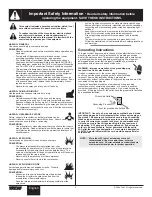
© Titan Tool. All rights reserved.
5
English
Preparing to Spray
ImPORTaNT: use a pot liner in the pressure pot when
spraying or cleaning with hot solvents such as lacquer-
based paints, lacquer thinner, and m.E.k. The use of hot
solvents in the pressure pot without a pot liner may lift the
paint off the interior of the pressure pot and contaminate the
paint finish. Refer to the parts list in this manual for the pot
liner part number.
1. Fill the pressure pot with spray material.
Cover
Groove
Seal
Locking
Clamp
Pressure
Pot
Pot
Liner
TIP: On smaller jobs a one-
gallon container may be
placed inside the pressure pot
to aid in quicker cleanup.
NOTE: For best results,
always strain material prior to
spraying.
NOTE: When using the one-
gallon container, take care not
to tip the Power cart back too
far in order to prevent material
from spilling out of the can.
2. Fasten the cover securely onto
the pressure pot by placing
the five locking clamps into
the cover grooves and rotating
each clockwise until hand tight.
Be certain that the seal is in
place.
3. Connect the pressure pot air
hose to the pressure pot air
inlet.
NOTE: The hose features quick-disconnect fittings.
To use, pull back on the spring-loaded collar
of each fitting. Slide the hose fitting over the
correct connection and release the collar.
Pressure Pot Air Inlet
Pressure Pot Air Hose
4. Plug in the power cords for both the Power Cart and the
turbine. Turn the cart power switch to the ON (I) position
to turn on the compressor.
NOTE: The compressor should run continuously (up to
2 minutes) upon initially charging the pressure
pot. as the compressor reaches the desired
pressure (set by the regulator), the compressor
will diminish its cycling rate. If the system
is left idle (i.e. no material being sprayed) for
several minutes, the compressor will cycle
periodically due to normal air losses. When the
system is idle the compressor may cycle up to
4 times per minute. If the compressor cycles
more frequently than this or does not stop, see
Troubleshooting section.
When material is being sprayed, the compressor
should normally cycle every 5-10 seconds.
5. Pull out the pressure control knob and turn it until the
pressure is set properly for the type of material you are
using.
For thin materials, set regulator to 8 PSI.
For thicker materials, set regulator to between 8 and
14 PSI.
Pressure
Control
Knob
Pressure Control Gauge
6. Turn on the turbine.
7. Practice spraying on a piece of scrap wood or cardboard
until you are satisfied with the pressure, spray pattern, and
spray shape. The spray pattern adjustments and spray
shape selections are described in your gun manual.
cleanup
1. Turn off the turbine.
2. Turn off the Power Cart.
3. Relieve the pressure from the pressure pot and remove
the pressure pot cover.
4. Remove excess material from the pot, wiping down the
inside of the pot and fluid pick-up tube.
5. Place a container of the appropriate cleaning solvent into
the pressure pot to clean out the hose and gun.
6. Replace the cover, making sure the pickup tube is inside
the solvent container, and tighten the pot cover.
7. Turn on the Power Cart and adjust the pressure to 10 psi.
8. With the turbine off, depress the spray gun trigger while
pointing the gun into the material container. This will drain
the material into the container until all material has been
pushed through.
9. Continue running the solvent through the hose and gun
until they are completely clean.





































